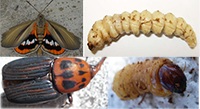|
This WP will be carried out by DAAM and BPI in collaboration with the ARI.
- Collected RPW adults (50 males and 50 females) from infested palms from each district of Cyprus (Limassol, Paphos, Larnaca, Famagusta, Nicosia, semi-mountainous areas) will be placed in the freezer (-20C). The 2 front (prothoracic) legs of RPW adults will be placed in a 1.5ml plastic tube and sent to the PA4 (DAAM lab) for the molecular characterization, identification and other analyses absolute ethanol.
- Palm borer Paysandisia archon was detected in 2008 only in the area of Paphos. If during this vitality project the insect will be found then we will proceed with the molecular studies.
- All the molecular work will be conducted according to published protocols: A) Protocolo de extracción de DNA (1. DNeasy Tissue Kit, 2. Protocolo de la técnica de PCR, 3. Protocolo de electrophoresis, 4. Protocolo de purificación de DNA (QIAquick PCR Purification Kit), Protocolo de reacción de secuenciación. B) Protocolos de preparación de reactivos (1. Protocolo de preparación de EDTA, 2. Protocolo de preparación de TAE, 3. Protocolo de preparación SDS 10% (detergente para eliminar trazas de DNA en pinzas, etc., 4) Protocolo de preparación de PBS (solución donde se coloca el insecto o parte de éste cuando se aplasta para extraer el DNA), 5. Protocolo de preparación de marcador de Peso Molecular (para saber aprox. el nº de pares de bases del fragmento de DNA estudiado).
- Extract of DNA will be conducted from the prothoracic legs using the procedure that is suggested by the DNeasy tissue kit (Qiagen)
- Study the DNA diversity (nucleotyde polymorphism) among specimens belonging to different populations of the RPW
- Develop a phylogenetic tree using various phylogenetic analyses
Deliverables
- D13. Table - Gene sequences and a Phylogenetic tree of RPW populations
|





